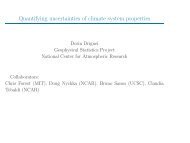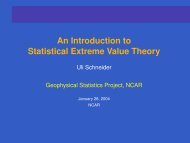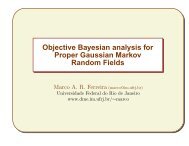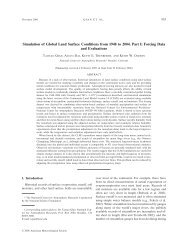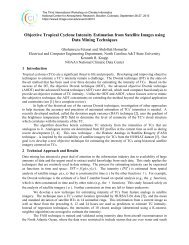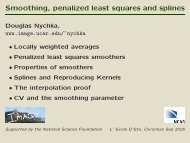A Spatial Analysis of Multivariate Output from Regional ... - IMAGe
A Spatial Analysis of Multivariate Output from Regional ... - IMAGe
A Spatial Analysis of Multivariate Output from Regional ... - IMAGe
Create successful ePaper yourself
Turn your PDF publications into a flip-book with our unique Google optimized e-Paper software.
2.1 Univariate CAR ModelsIn the univariate setting and assuming Gaussian conditional distributions for f(y i |y −i ), theconditional mean and conditional variance associated with f(y i |y −i ) are specified asE[y i |y −i ] = µ i +n∑b ij (y j − µ j ) and Var[y i |y −i ] = τi 2 > 0,j≠iwhere b ii = 0; i = 1, . . . , n. Under regularity conditions, this collection <strong>of</strong> conditionaldistributions gives rise to a joint Gaussian distribution,N ( µ, (I − B) −1 T ) , (1)where µ = (µ 1 , . . . , µ n ) ′ , I is an n × n identity matrix, B is the n × n matrix with the(i, j)-th element b ij , and T = diag(τ1 2 , . . . , τn). 2 The regularity conditions are on the spatialdependenceparameters, {b ij }, and they ensure that the resulting matrix, (I − B) −1 T, is abona fide covariance matrix; that is, (I − B) −1 T is symmetric and positive-definite. Thespatial dependence is induced by the autoregression, which is determined by setting thecoefficients b ij ≠ 0 if j ∈ N i (and 0 otherwise), where N i is a collection <strong>of</strong> indices thatdefine a neighborhood <strong>of</strong> the ith location in the spatial lattice.2.2 <strong>Multivariate</strong> CAR ModelsMardia (1988) extended the MRF model <strong>of</strong> Besag (1974) to the multivariate setting wherethere is more than one measurement at each lattice point. In particular, let y i be a p-dimensional random vector. Then, for i = 1, . . . , n, let f(y i |y −i ) be a Gaussian distribution<strong>of</strong> y i , given all random vectors except the ith, withE[y i |y −i ] = µ i + ∑ B ij (y j − µ j ) and Var[y i |y −i ] = T i ,j≠iwhere µ i is a p-dimensional vector, B ij is a p × p matrix, and T i is a p × p covariancematrix. Assume that B ij T j = T i B ′ ji, for all i, j = 1, . . . , n (to ensure symmetry). Further,assume B ii = −I and B ij ≠ 0 for j ∈ N i and i = 1, . . . , n. Under the assumption that the7



